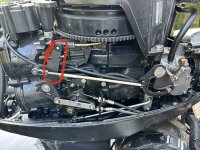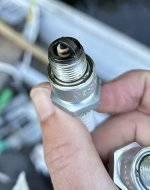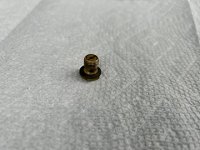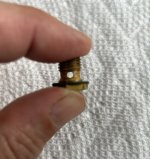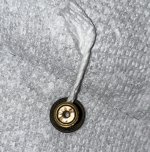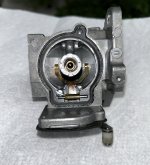the ill postino
New member
Hi all,
I'm having some trouble with my 1993 Mercury 25ELH 2 stroke outboard and hoping you can help.
I bought it two years ago and it worked pretty well for most of the time I've had it. It had a tendency to stall at idle after first start but if I got into gear pretty quickly it was fine all day.
Recently it stalled on the way back in to my dock and wouldn't re-start. So I took the carb out and cleaned it with gum-out. No obvious issues or gasket tears etc. Put it back together and it started right up but stalled after a minute or so. Couldn't get it started again. Took carb *back* out and tried to be even more thorough in inspecting and cleaning. Re-installed and it started right up. Then died.
This time I left it alone for a day and when I went back to it I figured out that I could start it by slightly advancing this arm (in red in picture 1) manually to give it more gas. After I let it run for a minute I turned it off and was able to start it by just pushing the starter (see video linked below.) Did some donuts around my dock, put it into reverse, forward, more donuts, but then it died and would not restart. The advance-the-arm trick no longer worked including after taking the plugs out and wiping them down.
I've replaced the gas tank and fuel line and fuel filter. Spark plugs are pretty new. A picture of one of the plugs after the latest stall is attached. Carb mixture screw is set to 1.5 turns out. I tried a half turn more closed and a half more open and it didn't seem to help. When it was running at 1.5 turns the idle sounded pretty good:
Thanks in advance for any suggestions!
I'm having some trouble with my 1993 Mercury 25ELH 2 stroke outboard and hoping you can help.
I bought it two years ago and it worked pretty well for most of the time I've had it. It had a tendency to stall at idle after first start but if I got into gear pretty quickly it was fine all day.
Recently it stalled on the way back in to my dock and wouldn't re-start. So I took the carb out and cleaned it with gum-out. No obvious issues or gasket tears etc. Put it back together and it started right up but stalled after a minute or so. Couldn't get it started again. Took carb *back* out and tried to be even more thorough in inspecting and cleaning. Re-installed and it started right up. Then died.
This time I left it alone for a day and when I went back to it I figured out that I could start it by slightly advancing this arm (in red in picture 1) manually to give it more gas. After I let it run for a minute I turned it off and was able to start it by just pushing the starter (see video linked below.) Did some donuts around my dock, put it into reverse, forward, more donuts, but then it died and would not restart. The advance-the-arm trick no longer worked including after taking the plugs out and wiping them down.
I've replaced the gas tank and fuel line and fuel filter. Spark plugs are pretty new. A picture of one of the plugs after the latest stall is attached. Carb mixture screw is set to 1.5 turns out. I tried a half turn more closed and a half more open and it didn't seem to help. When it was running at 1.5 turns the idle sounded pretty good:
Thanks in advance for any suggestions!


